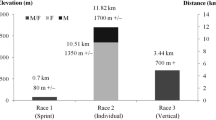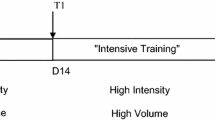Abstract
Purpose
Endurance exercise is associated with high cardiac vagal tone, but how the cardiac autonomic control correlates with shorter anaerobic performances is unknown. Therefore, the aim of this study was to evaluate how autonomic modulations of heart rate (HR) variability (V) correlate with performances of short- (<1 min) and very short (<30 s) duration in elite athletes.
Method
Thirteen male swimmers, national-level crawl specialists in short (100-m) and very short (50-m) distances, were enrolled. HR was recorded during 15-min supine rest: (1) in the morning after wake up, (2) in the afternoon before sprint-oriented training sessions, (3) few minutes after training (first recovery phase after swimming cooldown). Heart rate variability (HRV) vagal and sympatho/vagal indices were calculated in time, frequency and complexity domains. Correlations of best seasonal times on 100- or 50-m distances with HRV indices and the velocity at blood lactate accumulation onset (V OBLA) were calculated.
Results and conclusion
Vagal indices were highest in the morning where they positively correlated with very short-distance times (higher the index, worse is the 50-m performance). Sympatho/vagal indices were highest after training where they negatively correlated with short-distance times (higher the index, better is the 100-m performance). V OBLA did not correlate with the performances. Therefore, autonomic HRV indices and not V OBLA predict short and very short, most anaerobic, performances. Results also suggest that a strong cardiac vagal control has no effect on short performances and is even detrimental to very short performances, and that the capacity to powerfully increase the sympathetic tone during exercise may improve short, but not very short performances.





Similar content being viewed by others
Abbreviations
- HF:
-
High-frequency power
- HR:
-
Heart rate
- HRV:
-
Heart rate variability
- LFnu :
-
Normalized low-frequency power
- NN:
-
Normal-to-normal R–R intervals
- NN50+:
-
Hourly number of increases between consecutive NN intervals larger than 50 ms
- NN50−:
-
Hourly number of decreases between consecutive NN intervals larger than 50 ms
- pNN50+:
-
Proportion of beats with increases larger than 50 ms
- pNN50−:
-
Proportion of beats with decreases lower than 50 ms
- SampEn:
-
Sample entropy
- SD1 :
-
Dispersion of Poincarè plots around the identity line
- V OBLA :
-
Velocity at the onset of blood lactate accumulation
References
Arai Y, Saul JP, Albrecht P, Hartley LH, Lilly LS, Cohen RJ, Colucci WS (1989) Modulation of cardiac autonomic activity during and immediately after exercise. Am J Physiol 256:H132–H141
Atlaoui D, Pichot V, Lacoste L, Barale F, Lacour JR, Chatard JC (2007) Heart rate variability, training variation and performance in elite swimmers. Int J Sports Med 28:394–400
Aubert AE, Seps B, Beckers F (2003) Heart rate variability in athletes. Sports Med 33:889–919
Bauer A, Kantelhardt JW, Barthel P, Schneider R, Makikallio T, Ulm K, Hnatkova K, Schomig A, Huikuri H, Bunde A, Malik M, Schmidt G (2006) Deceleration capacity of heart rate as a predictor of mortality after myocardial infarction: cohort study. Lancet 367:1674–1681
Bigger JT Jr, Kleiger RE, Fleiss JL, Rolnitzky LM, Steinman RC, Miller JP (1988) Components of heart rate variability measured during healing of acute myocardial infarction. Am J Cardiol 61:208–215
Bonifazi M, Martelli G, Marugo L, Sardella F, Carli G (1993) Blood lactate accumulation in top level swimmers following competition. J Sports Med Phys Fitness 33:13–18
Bosquet L, Merkari S, Arvisais D, Aubert AE (2008) Is heart rate a convenient tool to monitor over-reaching? A systematic review of the literature. Br J Sports Med 42:709–714
Brennan M, Palaniswami M, Kamen P (2001) Do existing measures of Poincare plot geometry reflect nonlinear features of heart rate variability? IEEE Trans Biomed Eng 48:1342–1347
Brennan M, Palaniswami M, Kamen P (2002) Poincare plot interpretation using a physiological model of HRV based on a network of oscillators. Am J Physiol Heart Circ Physiol 283:H1873–H1886
Castiglioni P, Parati G, Omboni S, Mancia G, Imholz BP, Wesseling KH, Di Rienzo M (1999) Broad-band spectral analysis of 24 h continuous finger blood pressure: comparison with intra-arterial recordings. Clin Sci (Lond) 97:129–139
Castiglioni P, Parati G, Civijian A, Quintin L, Di Rienzo M (2009) Local scale exponents of blood pressure and heart rate variability by detrended fluctuation analysis: effects of posture, exercise, and aging. IEEE Trans Biomed Eng 56:675–684
Castiglioni P, Parati G, Di Rienzo M, Carabalona R, Cividjian A, Quintin L (2011a) Scale exponents of blood pressure and heart rate during autonomic blockade as assessed by detrended fluctuation analysis. J Physiol 589:355–369
Castiglioni P, Parati G, Lombardi C, Quintin L, Di Rienzo M (2011b) Assessing the fractal structure of heart rate by the temporal spectrum of scale exponents: a new approach for detrended fluctuation analysis of heart rate variability. Biomed Tech (Berl) 56:175–183
Di Rienzo M, Castiglioni P, Mancia G, Parati G, Pedotti A (1989) 24 h sequential spectral analysis of arterial blood pressure and pulse interval in free-moving subjects. IEEE Trans Biomed Eng 36:1066–1075
Dixon EM, Kamath MV, McCartney N, Fallen EL (1992) Neural regulation of heart rate variability in endurance athletes and sedentary controls. Cardiovasc Res 26:713–719
Ekblom B, Kilbom A, Soltysiak J (1973) Physical training, bradycardia, and autonomic nervous system. Scand J Clin Lab Invest 32:251–256
Ewing DJ, Neilson JM, Travis P (1984) New method for assessing cardiac parasympathetic activity using 24 hour electrocardiograms. Br Heart J 52:396–402
Faude O, Meyer T, Scharhag J, Weins F, Urhausen A, Kindermann W (2008) Volume vs. intensity in the training of competitive swimmers. Int J Sports Med 29:906–912
Furlan R, Piazza S, Dell’Orto S, Gentile E, Cerutti S, Pagani M, Malliani A (1993) Early and late effects of exercise and athletic training on neural mechanisms controlling heart rate. Cardiovasc Res 27:482–488
Garet M, Tournaire N, Roche F, Laurent R, Lacour JR, Barthelemy JC, Pichot V (2004) Individual Interdependence between nocturnal ANS activity and performance in swimmers. Med Sci Sports Exerc 36:2112–2118
Goldsmith RL, Bigger JT Jr, Bloomfield DM, Steinman RC (1997) Physical fitness as a determinant of vagal modulation. Med Sci Sports Exerc 29:812–817
Iellamo F, Legramante JM, Pigozzi F, Spataro A, Norbiato G, Lucini D, Pagani M (2002) Conversion from vagal to sympathetic predominance with strenuous training in high-performance world class athletes. Circulation 105:2719–2724
Kasikcioglu E (2011) The incognita of the known: the athlete’s heart syndrome. Anadolu Kardiyol Derg 11:351–359
Laursen PB (2010) Training for intense exercise performance: high-intensity or high-volume training? Scand J Med Sci Sports 20(Suppl 2):1–10
McNarry MA, Lewis MJ (2012) Interaction between age and aerobic fitness in determining heart rate dynamics. Physiol Meas 33:901–914
Nobrega AC, O’Leary D, Silva BM, Marongiu E, Piepoli MF, Crisafulli A (2014) Neural regulation of cardiovascular response to exercise: role of central command and peripheral afferents. Biomed Res Int 2014:478965
Peng CK, Havlin S, Hausdorff JM, Mietus JE, Stanley HE, Goldberger AL (1995) Fractal mechanisms and heart rate dynamics. Long-range correlations and their breakdown with disease. J Electrocardiol 28:59–65
Penttila J, Helminen A, Jartti T, Kuusela T, Huikuri HV, Tulppo MP, Coffeng R, Scheinin H (2001) Time domain, geometrical and frequency domain analysis of cardiac vagal outflow: effects of various respiratory patterns. Clin Physiol 21:365–376
Pichot V, Roche F, Gaspoz JM, Enjolras F, Antoniadis A, Minini P, Costes F, Busso T, Lacour JR, Barthelemy JC (2000) Relation between heart rate variability and training load in middle-distance runners. Med Sci Sports Exerc 32:1729–1736
Porta A, Gnecchi-Ruscone T, Tobaldini E, Guzzetti S, Furlan R, Montano N (2007) Progressive decrease of heart period variability entropy-based complexity during graded head-up tilt. J Appl Physiol 103:1143–1149
Porta A, Casali KR, Casali AG, Gnecchi-Ruscone T, Tobaldini E, Montano N, Lange S, Geue D, Cysarz D, Van Leeuwen P (2008) Temporal asymmetries of short-term heart period variability are linked to autonomic regulation. Am J Physiol Regul Integr Comp Physiol 295:R550–R557
Pu Y, Patterson RP (2003) Comparison of R-wave detection errors of four wireless heart rate belts in the presence of noise. Physiol Meas 24:913–924
Richman JS, Moorman JR (2000) Physiological time-series analysis using approximate entropy and sample entropy. Am J Physiol Heart Circ Physiol 278:H2039–H2049
Schmitt L, Hellard P, Millet GP, Roels B, Richalet JP, Fouillot JP (2006) Heart rate variability and performance at two different altitudes in well-trained swimmers. Int J Sports Med 27:226–231
Shiotani H, Umegaki Y, Tanaka M, Kimura M, Ando H (2009) Effects of aerobic exercise on the circadian rhythm of heart rate and blood pressure. Chronobiol Int 26:1636–1646
Tarvainen MP & Niskanen JP (2012). Kubios HRV 2.1 User’s Guide, University of Eastern Finland, Kuopio, Finland
Task Force of the European Society of Cardiology and the North American Society of Pacing and Electrophysiology (1996) Heart rate variability: standards of measurement, physiological interpretation and clinical use. Circulation 93:1043–1065
Tulppo MP, Makikallio TH, Seppanen T, Shoemaker K, Tutungi E, Hughson RL, Huikuri HV (2001) Effects of pharmacological adrenergic and vagal modulation on fractal heart rate dynamics. Clin Physiol 21:515–523
Wilhelm M, Roten L, Tanner H, Wilhelm I, Schmid JP, Saner H (2011) Atrial remodeling, autonomic tone, and lifetime training hours in nonelite athletes. Am J Cardiol 108:580–585
Zamparo P, Capelli C, Pendergast D (2011) Energetics of swimming: a historical perspective. Eur J Appl Physiol 111:367–378
Acknowledgments
We sincerely thank all the DDS athletes who participated in the study and their medical manager, Dr. F. Confalonieri, for the patience and courtesy.
Author information
Authors and Affiliations
Corresponding author
Additional information
Communicated by Jean-René Lacour.
Rights and permissions
About this article
Cite this article
Merati, G., Maggioni, M.A., Invernizzi, P.L. et al. Autonomic modulations of heart rate variability and performances in short-distance elite swimmers. Eur J Appl Physiol 115, 825–835 (2015). https://doi.org/10.1007/s00421-014-3064-x
Received:
Accepted:
Published:
Issue Date:
DOI: https://doi.org/10.1007/s00421-014-3064-x




